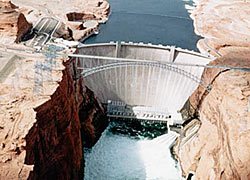Why was Glen Canyon Dam built?
 |
|
Glen Canyon Dam. |
The construction of Glen Canyon Dam was authorized by the Colorado River
Storage Project (CRSP), which was passed by a slim Congressional
majority on March 1, 1956. Construction of the Dam began a year
later, with no environmental review of impacts conducted whatsoever.
(The National Environmental Policy Act, which requires Environmental
Impact Statements to be conducted, was not yet in existence.)
The political motivation for the construction of the
dam came from the Upper Basin states (Colorado, Wyoming, Utah, and
New Mexico), who wanted to preserve their claims to shares of the
river's water, as apportioned to them in the 1922 Colorado River
Compact. By the 1940's, it was realized that the Compact had grossly
overestimated the annual flow of the river; only through impoundment
could the Upper Basin states ensure that their claims would remain
valid.
The dam became politically feasible, in the eyes of
fiscal conservatives, when the Bureau of Reclamation adopted an
accounting system called "river basin accounting." Under
this system, the electricity generated by Glen Canyon Dam (currently
less than 3% of the Southwest's needs) would pay for the construction
of other, smaller irrigation dams authorized by the CRSP. In short,
Glen Canyon Dam was designed to be a "cash cow" for the
Bureau of Reclamation; even today, not a single drop of Lake Powell
water is used for commercial irrigation purposes.
Five million yards of concrete were poured nonstop
at the dam site between June 1960 and September 1962; upon completion,
the total height of the dam stood at 710 feet. When full, the water
in Glen Canyon averages 560 feet in depth, flooding 180 miles up
Glen Canyon, making "Lake" Powell the second largest man-made
reservoir in the Western Hemisphere.
|


